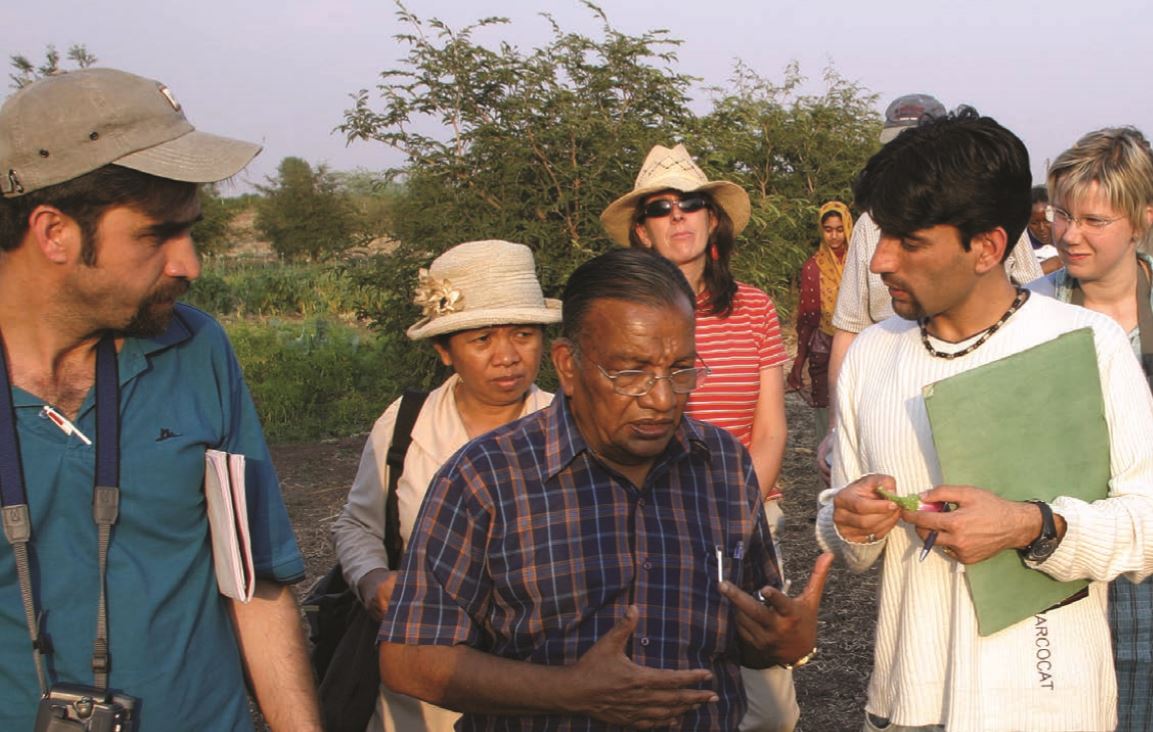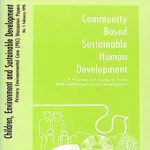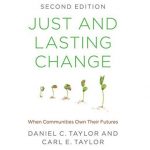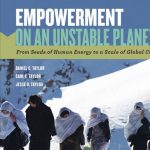Humanity may be jeopardizing its future by persisting in using inappropriate analytical models to engage the hyper-complex interlinked global system of world economics, natural environment, and more than seven billion humans. The specific concern is that we may be using reductionist approaches for that do not address the hyper-complex character of the interlinked global system. SEED-SCALE is an analytical frame grounded in complexity theory where results are recognized “to emerge” from processes rather than be controlled by inputs.
Contributions
Contributions from Complexity Theory
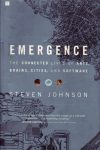
Stephen Johnson, Emergence (New York: Scribner, 2001)
From Chapter One (page 27)
“Cities have no central planning commission that solve the problem of purchasing and distributing supplies…. How do these cities avoid devastating swings between shortage and glut, year after year, decade after decade? The mystery deepens when we observe the kaleidoscopic nature of large cities. Buyers, sellers, administrations, streets, bridges, and buildings are always changing, so that a city’s coherence is somehow imposed on a perpetual flux of people and structures. Like the standing wave in front of a rock in a fast-moving stream, a city is a pattern in time.” (quoting John Holland)
From Introduction (pages 18 & 21)
“What features do all these systems share? In the simplest terms, they solve problems by drawing on masses of relatively stupid elements, rather than a single, intelligent “executive branch.” They are bottom-up systems, not top-down. They get their smarts from below. In a more technical language, they are complex adaptive systems that display emergent behavior. In these systems, agents residing on one scale start producing behavior that lies one scale above them: ant colonies, urbanites create neighborhoods; simple pattern-recognition software learns how to recommend new books. The movement from low-level rules to higher-level sophistication is what we call emergence….
But,…we stopped analyzing emergence and started creating it. We began building self-organizing systems into our software applications, our video games, our art, our music. We build emergent systems to recommend new books, recognize our voices, or find mates. For as long as complex organisms have been alive, they have lived under the laws of self-organization, but in recent years our day-to-day life has become overrun with artificial emergence: systems built with a conscious understanding of what emergence is, systems designed to exploit those laws the same way our nuclear reactor exploit the laws of atomic physics.” (With in social domains similar results of massive energy generation; now in human energy generation).

John H. Holland, Emergence: From Chaos to Order, (Cambridge MA: Perseus Books, 1998)
From Chapter 1 (pages 2 – 7)
“The hallmark of emergence is this sense of much coming from little. This feature also makes emergence mysterious, almost paradoxical, phenomenon smacking of “get rich quick” schemes. Yet emergence is a ubiquitous feature of the world around us. Mundane activities such as farming depend on rules of thumb for emergence—for example, knowing the conditions that influence the germination of seeds….
We are everywhere confronted with emergence in complex adaptive systems—ant colonies, networks of neurons, the immune system, the Internet, and the global economy, to name a few—where the behavior of the whole is much more complex than the behavior of the parts. There are deep questions about the human condition that depend on understanding the emergent properties of such systems: How do living systems emerge from the laws of physics and chemistry? Can we explain consciousness as an emergent property of certain kinds of physical systems? We will now know the limitations of scientific answers to questions like these until we understand the whys and wherefores of emergent phenomena.”…
“A small number of rules or laws can generate systems of surprising complexity. Moreover, this complexity is not just the complexity of random patterns. Recognizable features exist, as in a pointillist painting. In addition, the systems are animated—dynamic; they change over time. Though the laws are invariant, the things they govern change….the rules or laws generate the complexity, and the ever-changing flux of patterns that follows leads to perpetual novelty and emergence. Indeed, in most cases we will not understand these complex systems until we understand the emergent phenomena that attend them.”…
“The new examples also demonstrate that emergence usually involves patterns of interaction that persist despite a continual turnover in the constituents of the patterns. A simple example is the standing wave in front of a rock in a white-water river. The water molecules making up the wave change instant by instant, but the wave persists as long as the rock is there and the water flows. Ant colonies, cities, and the human body (which turns over all of its constituent atoms in less than two years) offer more complex examples.”
From Chapter 5 (pages 113 – 114)
How do humans, with their limited capacity for tracing out complexities, manage to select interesting rules and mechanisms? How does the scientist select the “laws” that are so effective at uncovering unexpected phenomena in the world?
The whole process of constructing rule-based model starts when our attention is attracted to some complex patter in the world—the movement of armies in battle, or the patterns of the “wanderers” (planets) in the night sky? At this point we do not have the benefit of the hindsight provided by years of study of the candidate rules. We could could attempt to derive some of the deeper consequences of different rule choices before making a selection, but do to so would consume inordinate amounts of time….
Almost by definition, the selection process must be a matter of induction—moving from particulars to abridged, more abstract descriptions. Once again, we encounter the importance of dropping selected details.”
From Chapter 6 (pages 115 – 116)
“Let’s review some of the common elements of the examples of emergence:
Each example, in one way or another, models the world….
Each model consists of multiple interacting copies of a limited number of pieces, particles, or components (types)….
The configuration of the model’s components changes as time elapses. With careful modeling, the particular configuration of the components at any time fully determines what can happen next….
Interactions are constrained by a succinct list of rules (equations). All possible state (configuration) sequences are the outcomes of a succession of limited rearrangements specified by these rules.”
Contributions from Business Management
Edwards Deming was a pioneer in using data to drive business decisions. He advanced the concept of Plan-Do-Study-Act with those four functions cycling for continuing improvement. Until this insight that got inside the process of production, industry had primarily used an input-output analysis. Efficiency and effectiveness were measured but not understood in how they were created through using statistical tools.
To unpack this cycle to be practically used, Deming advanced what his System of Profound Knowledge (note parallel to SEED-SCALE arguing for a System of Thought, contrasted with a Method or Tools.) There are also four principles:
- Appreciation of a system as a system, not parts
- Knowledge that the system always varies in its causes and quality, so statistical sampling must be on-going.
- Limits to knowledge exist; use what is accessible, never will enough information be at hand.
- Bring in concepts of Nature—the real world shows how systems balance—even industrial production is not an engineering production. 1
Total Quality Management Pursues on-going rise of quality by incremental increases using constant evaluation and improvement. Product can always get a bit better, not only in quality but also in the making of it—more efficiently, effectively, and with flexibility. To do so, organizations (communities in social change) must “install and make permanent a climate where employees (citizens) continuously improve their ability to provide … particular value.” [2] Everybody is involved, not just Management, as the word management refers (not to the leader with a capital “M,” but to the process of all advancing the product. Everyone focuses on overall quality, using evidence to see that quality continually rises. In managing community development, then, no community is “developed” or “underdeveloped,” but all are “always developing” as best they can to their time, place, and resources.
Agile Software Development – recent experience creating information software helps frame thinking on how community systems can grow. The parallel to IT is real—many solutions are possible, simple moving around of ideas results in radically differing performances. So, how can community operating software learn from IT? One way is to have self-organizing teams (a concept that fits with Emergence, discussed below). Another way is to promote cross-functional groupwork (people call that multi-tasking). A third way is to grow solutions Iteratively—SEED-SCALE makes Iteration into one of the five criteria by which to monitor change. Short answers that advance, never getting the full answer, but continually getting closer. Steps are small, risk minimized, results accepted or rejected whether to continue in that direction. Agile Software Development has twelve principles, while designed to move electrons in zeros and ones, they also transfer to human energy:[3]
- Customer satisfaction by early and continuous delivery of valuable software.
- Welcome changing requirements, even in late development.
- Deliver working software frequently (weeks rather than months)
- Close, daily cooperation between business people and developers
- Projects are built around motivated individuals, who should be trusted
- Face-to-face conversation is the best form of communication (co-location)
- Working software is the primary measure of progress
- Sustainable development, able to maintain a constant pace
- Continuous attention to technical excellence and good design
- Simplicity—the art of maximizing the amount of work not done—is essential
- Best architectures, requirements, and designs emerge from self-organizing teams
- Regularly, the team reflects on how to become more effective, and adjusts accordingly
Footnotes
[1] W. Edwards Deming, The New Economics for Industry, Government, and Education. (Cambridge, Massachusetts: MIT Press) page. 132.
[2] Dan Ciampa, Total Quality: A User’s Guide for Implementation, (Reading, Massachusetts, Addison-Wesley, 1992) page xxii.
[3] Kent Beck, James Grenning; Robert C. Martin; Mike Beedle; Jim Highsmith; Steve Mellor; Arie van Bennekum; Andrew Hunt; Ken Schwaber; Alistair Cockburn; Ron Jeffries; Jeff Sutherland; Ward Cunningham; Jon Kern; Dave Thomas; Martin Fowler; Brian Marick. “Principles behind the Agile Manifesto”. Agile Alliance. 14 June 2010.
Contributions from Architecture
Architecture is overlooked in most community development training/thinking (which has been so dominated by economics or services delivery). Architecture is a distinctive, helpful discipline because it views community visually and functionally. Powerfully positioning SEED-SCALE concepts were the insights of Christopher Alexander—who among many insights includes the idea of patterns of knowledge that directly informed creating Wikipedia. Specifically relevant to SEED-SCALE is his assertion that anyone can design and build their holistic space at any scale.

From The Timeless Way of Building, Christopher Alexander, (Oxford Press: 1979)
“There is one timeless way of building.
It is thousands of years old, and the same today as it has always been.
The great traditional buildings of the past, the villages and tents and temples in which man feels at home, have always been made by people who were very close to the center of the way. It is not possible to make great buildings, or great towns, beautiful places, places where you feel yourself, places where you feel alive, except by following this way. And, as you will see, this way will lead anyone who looks for it to buildings which are themselves as ancient in their form, as the trees and hills, and as our faces are.
It is a process through which the order of a building or a town grows directly from the inner nature of the people, and the animals, and plants, and matter which are in it.
It is a process, which allows the life inside a person, or a family, or a town, to flourish, openly, in freedom, so vividly that it gives birth, of its own accord, to the natural order which is needed to sustain this life.
It is so powerful and fundamental that with its help you can make any building in the world as beautiful as any place that you have ever seen.
Once you understand this way, you will be able to make your room alive; you will be able to design a house together with your family; a garden for your children; places where you work; beautiful terraces where you can sit and dream.
(p. 10) And there is a way that a building or a town can actually be brought to life like this.
There is a definable sequence of activities which are at the heart of all acts of building, and it is possible to specify, precisely, under what conditions these activities will generate a building which is alive. All this can be made so explicit that anyone can do it.
And just so, the process by which a group of independent people make part of a town alive can equally be made precise. Again, there is a definable sequence of activities, more complex in this case, which are at the heart of all collective building processes, and it is possible to specify exactly when these processes will bring things to life. And, once again, these processes can be made so explicit, and so clear, that any group of people can make use of them.
(p. 13) Indeed it turns out, in the end, that what this method does is simply free us from al method.
The more we learn to use this methods, the more we find that what it does is not so much to teach us processes we did not know before, but rather opens up a process in us, which was part of us already.
We find out that we already know how to make buildings live, but that the power has been frozen in us: that we have it, but are afraid to use it: that we are crippled by our fears; and crippled by the methods and the images which we use to overcome these facts.
And what happens finally is that we learn to overcome our fears, and reach that portion of our selves which knows exactly how to make a building live, instinctively. But we learn too, that this capacity in us is not accessible, until we first go through the discipline which teaches us to let go of our fears.
The power to make buildings beautiful lies in each of us already.
It is so simple, and so deep, that we are born with it. This is no metaphor. I mean it literally. Imagine the greatest possible beauty and harmony in the world—the most beautiful place that you have ever seen or dreamt of. You have the power to create it, at this very moment, just as you are.
And this power we have is so firmly rooted and coherent in every one of us that once it is liberated, it will allow us, by our individual, unconnected acts, to make a town, without the slightest need for plans, because, like every living process, it is a process which builds order out of nothing.
(p383) In nature, a thing is always born, and developed, as a whole
A baby starts, from the first day of its conception, as a whole, and is a whole, as an embryo, every day until it is born. It is not a sequence of adding parts together, but a whole, which expands, crinkles, differentiates itself.
A wave is shaped as a whole. It is part of the system of waves, and is part of a legitimate well-formed living whole, as it starts, swells, crashes, and dies.
A mountain is shaped as a whole: the crust of the earth heaves, the mountain takes its form; and while it is growing, each rock, and particle of sand is also whole: there is nothing unfinished in it, during the thousands of years that bring it to the state we know today. ….
And it follows, therefore, that when a pattern language is properly used, it allows the person who uses it to make places which are part of nature.
The character of nature is not something added to a good design. It comes directly from the order of the language. When the order of the patterns in the language is correct, the differentiating process allows the design to unfold as smoothly as an opening flower.
Contributions from Participatory Reflection and Action (PRA)
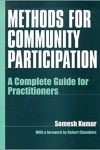
Somesh Kumar Methods for Community Participation: A Complete Guide for Practitioners (Warwickshire: Intermediate Technology Publications, 2002).
From the Foreword by Robert Chambers (page 15)
“The widespread adoption of the rhetoric of participation in development is welcome for the legitimacy and space it accords to those who genuinely want to practice it. In parallel, the phenomenal spread of practices described as PRA (originally Participatory Rural Appraisal, now sometimes Participatory Reflection and Action) has shown practical ways in which participation can be made real, and has inspired and provided opportunities for many. These successes have brought many benefits. Among the best have been the empowerment of poor people through their own analysis and action, and new insight gained by professionals into their realities and priorities.
There have also been many problems. Much of the rhetoric has been cosmetic and hypocritical as advocates and practitioners have failed to realize the need for personal and institutional change. The practice with communities and poor people has often been exploitive, wasting their time and raising their expectations when the main beneficiaries are the facilitators who extract data and use it for their own purposes. Those who take part in appraisal and analysis have often been members of local elites whose interests, rather than those of the poorer, have tended to take precedence. Consultants and trainers claimed proficiency in PRA and gained contracts when they are anything but proficient—their attitudes and behaviour are superior and dominating, and they are given to imposing their own ideas as they have always done. Many have thought that PRA begins and ends with methods, and have applied these in standardized top-down and exploitive manner. Many have failed to realize the importance of “handing over the stick” and using PRA approaches and methods as part of longer processes of empowerment for those who are poor, marginalized and weak. Many have used PRA methods for their research and have raised ethical questions about raising people’s expectations and taking their time while giving nothing back.”
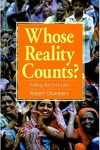
Robert Chambers, Whose Reality Counts? Putting the first last (London: Intermediate Technology Development Group, 1997)
From Chapter 7 (pages 130 – 135)
“This is astonishing. We know each of these pieces because they are parts of our existence. But we have never thought of it all put together like this. This is our life and our history.”
(Villager in Sinthiane, Senegal, after completing a historical matrix, quoted in K. and M. Schoonmaker Freudenberger, 1994: 148)
“And we thought we were so foolish because we could not write. Yet look, we had all this information inside us.”
A Tembomvura woman, Zimbabwe, to Ravai Marindo-Ranganai (1996:188) after PRA modeling and diagramming
The PRA experience has led to insights and discoveries: that local people have largely unexpected capabilities for appraisal, analysis and planning, that the behaviour and attitudes of outsiders are critical in facilitation; that diagramming and visual sharing are popular and powerful in expressing and analyzing complexity; and that sequences of PRA methods can be strong. The validity and reliability of information shared through PRA approaches and methods have usually been high. Explanations include the reversals and shifts inherent in PRA; from closed to open, and from etic to emic; from measuring to comparing; from individual to group; from verbal to visual; from higher to lower; from reserve to rapport; and from frustration to fun. Done well, these shifts and reversals reinforce a shift of power, from extracting to empowering. Local analysts then own the outputs in a process leading to planning and action.”…
“The discovery here has been that local people have capabilities of which outsiders have been largely, or totally, unaware. In learning what local people could do, it is as thought a succession of dominoes has fallen.
First, local people have shown a far greater ability to map, model, observe, list, count, estimate, compare, rank, score and diagram than most outsiders had supposed. Much of this is through visualization, the physical expression and sharing of knowledge, judgement and analysis: people make maps, models, lists, matrices, and diagrams; they walk transects and observe; they investigate and interview; they present information; they analyze and plan. In consequence, they are more in command of the process, they own and retain more of the information, and they are better placed to identify their priorities for action, and to determine and control that action….
“The second insight here has been the importance of outsiders’ behaviour and of relaxed rapport established early in the process…. Rapport is a key to facilitating participation. Relaxed rapport between outsiders and local people, and some measure of trust, are minimum conditions for PRA….Empirically, though, the recurrent finding with PRA has been that if the initial behaviour and attitudes of outsiders are relaxed and right, and if the process can start, the methods of PRA themselves foster further rapport….
“The third discovery here is the popularity and power of participatory diagramming and visual sharing. Diagramming and visual sharing are common elements in much PRA. With a questionnaire survey, information is transferred from the words of the person interviewed to the paper of the questionnaire schedule. The learning is one-off. The information becomes personal and private, unverified, and processed and appropriated by the interviewer. In contrast, with visual sharing of a map, model, diagram, or units (stones, seeds, small fruits, etc.) or lengths (stick, etc.) used for counting, estimating, ranking, scoring, and comparing, it is open to all who are present to participate. Different people add details, and crosscheck and correct each other.
The fourth discovery is that visual arrangements, tools and materials can be combined in many ways and so applied in many forms. The arrangements, tools and materials include maps, models, cards, lists, symbols, diagrams, matrices, counters, the ground, chalk, paper, pens. New combinations and applications are continuously being improvised and invented.”
Contributions from Asset Based Community Development (ABCD)
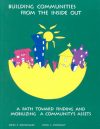
John P. Kretzmann & John L. McKnight Building Communities from the Inside Out: A Path Toward Finding and Mobilizing a Community’s Assets (Skokie IL: ACTA Publications, 1993)
From the Introduction (pages 1 – 6)
“Well-intended people are seeking solutions by taking one of two divergent paths. The first, which begins by focusing on a community’s needs, deficiencies and problems, is still by far the most traveled, and commands the vast majority of our financial and human resources. By comparison with the second path, which insists on beginning with a clear commitment to discovering a community’s capacities and assets, and which is the direction this guide recommends, the first and more traditional path is more like an eight-lane superhighway.…
(The) “needs” map determines how problems are to be addressed, through deficiency-oriented policies and programs. Public, private and nonprofit human service systems, often supported by university research and foundation funding, translate the programs into local activities that teach people the nature and extent of their problems, and the value of services as the answer to their problems. As a result, many lower income urban neighborhoods are now environments of service where behaviors are affected because residents come to believe that their well-being depends upon being a client. They begin to see themselves as people with special needs that can only be met by outsiders. They become consumers of services, with no incentive to be producers….
To create a wall between lower income communities and the rest of society—a wall of needs which, ironically enough, is built not on hatred but (at least partially) on the desire to “help” .… They think of themselves and their neighbors as fundamentally deficient, victims incapable of taking charge of their lives and their community’s future….
The Alternative Path: Capacity-Focused Development
The Alternative path, very simply, leads toward development of policies and activities based on the capacities, skills and assets of lower income people and their neighborhoods.
In addition to the problems associated with the dominant deficiency model, at least two more factors argue for shifting to a capacity-oriented emphasis. First, all the historic evidence indicates that significant community development takes place only when local community people are committed to investing themselves and their resources in the effort. This observation explains why communities are never built from the top down, or from the outside in….
The second reason for emphasizing the development of the internal asssets of local urban neighborhoods is that the prospect for outside help is bleak indeed. Even in areas designated as Enterprise Zones, the odds are long that large-scale, job-providing industrial or service corporations will be locating in these neighborhoods. Nor is it likely, in the light of continuing budget constraints, that significant new inputs of federal money will be forthcoming soon….
Creative neighborhood leaders across the country have begun to recognize this hard truth, and have shifted their practices accordingly. They are discovering that wherever there are effective community development efforts, those efforts are based upon an understanding, or map, of the community’s assets, capacities and abilities. For it is clear that even the poorest neighborhood is a place where individuals and organizations represent resources upon which to rebuild. The key to neighborhood regeneration, then, is to lcocate all of the available local assets, to begin connecting them with one another in ways that multiply their power and effectiveness, and to begin harnessing those local institutions that are not yet available for local development purposes….
Each community boats a unique combination of assets upon which to build its future. A thorough map of those assets would begin with an inventory of the fits, skills and capacities of the community’s resident. Household by household, building by building, block by block, the capacity mapmakers will discover a vast and often surprising array of individual talents and productive skills.”
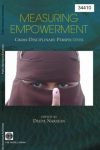
Deepa Narayan (editor), Measuring Empowerment: Cross Disciplinary Perspectives (Oxford: Oxford University Press, 2006)
From Chapter One (pages 3 – 6)
“Empowerment is not a new concept. Every society has local terms for autonomy, self-direction, self-confidence, self-worth. What is new is the attempt to measure empowerment in a systematic way.
The Voices of the Poor study conducted in 60 countries showed that voicelessness and powerlessness are pervasive among the poor, affecting every aspect of their lives. ((Narayan, Patel, et al Can Anyone Hear Us?; Narayan, Chambers, et al Crying Out for Change; Narayan and Petesch, From Many Lands) Trapped in poverty and barred from opportunity, poor people live with little expectation that tomorrow will bring anything good, despite their arduous work. In recognition of these realities, the World Bank has identified a two-pronged strategy to reduce poverty on a large scale. The strategy focuses on improving the overall investment climate in developing countries and on empowering people by investing in their assets.
An empowering approach to poverty reduction is grounded in the conviction that poor people themselves are invaluable partners for development, since they are the most motivated to move out of poverty. Nobody has more at stake in reducing poverty than poor people themselves. A growing body of evidence points to linkages between empowerment and development effectivness at both the society-wide scale and at the grassroots level. (Narayan Empowerment and Poverty Reduction: A Sourcebook, 2002) Empowerment approaches can strengthen good governance, which in turn enhances growth prospects. When citizens are engaged, exercise voice, and demand accountability, government performance improves and corruption is harder to sustain. Citizen participation can also build consensus in support of difficult reforms needed to create a positive investment climate and induce growth. In addition, the empowerment agenda supports development effectiveness by promoting growth patterns that are pro-poor. This involves reducing inequalities by investing in poor people’s capabilities through education and access to basic health care, as well as by increasing their access to land, financial capital, and markets.
Experience also demonstrates that empowerment can improve development effectiveness and pro-poor impact at the individual project level. Under certain conditions, grassroots community involvement is a powerful tool for the production, monitoring, and maintenance of local public good such as water supply, sanitation, schools, health clinics, roads, and forests, which in turn increases the development effectiveness of investments. Empowerment strategies at the project level are supported by civil liberties in society. Evidence shows that projects in countries with strong civil liberties—particularly citizen voice, participation, and accountability—significantly outperform projects in countries with weak civil liberties.
However, despite this widespread interest in and support for empowerment, work has only recently begun on construction of an analytical framework on empowerment that can be used to guide state reform and action. The World Bank’s Empowerment and Poverty: A Sourcebook provides an outline of such a framework. (Narayan, 2002). It views empowerment broadly as increasing poor people’s freedom of choice and action to share their own lives. It identifies four key elements that can change power relations between poor people and powerful actors: access to information, inclusion and participation, social accountability, and local organizational capacity.”….
“The Empowerment Framework:
In order to measure and monitor empowerment, it is important to have a clear definition of the concept and to specify a framework that both links empowerment to improved development outcomes and identifies determinants of empowerment itself.
Empowerment refers broadly to the expansion of freedom of choice and action to shape one’s life. It implies control over resources and decisions. For poor people, that freedom is severely curtailed by their powerlessness in relation to a range of institutions, both formal and informal. Since powerlessness is embedded in a culture of unequal institutional relations an institutional definition of empowerment has been adopted:
Empowerment is the expansion of assets and capabilities of poor people to participate in, negotiate with, influence, control, and hold accountable institutions that affect their lives.
This definition can be applied to understand and track changes in the unequal relationship between poor people and the state, markets, or civil society, as well as gender inequalities, even within the household.
Moving from this broad definition, with its emphasis on institutions and interaction between poor people and more powerful actors, figure 1.1 outlines a conceptual framework that is helpful in understanding the key factors that facilitate or constrain poor people’s efforts to improve their own well-being and also affect boarder development outcomes.
The conceptual framework contains four building blocks:
- Institutional climate
- Social and political structures
- Poor people’s individual assets and capabilities
- Poor people’s collective assets and capabilities
The concepts of opportunity structure and agency developed by Patti Petesch, Catalina Smulovitz, and Michael Walton are superimposed on these four building blocks. The first two building blocks constitute the opportunity structure that poor people face, while the second two make up the capacity for agency of poor people themselves. The opportunity structure of a society is defined by the broader institutional, social, and political context of formal and informal rules and norms within which actors pursue their interests. Agency is defined by the capacity of actors to take purposeful action, a function of both individual and collective assets and capabilities. All four components influence each other, and together they have effects on development outcomes. Empowerment of poor, excluded, or subordinate groups is a product of the interaction between the agency of these individuals and groups and the opportunity structure in which this agency is potentially exercised.”
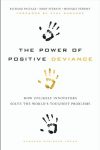
Richard Pascale, Jerry Sternin, and Monique Sternin, The Power of Positive Deviance: How Unlikely Innovators Solve the World’s Toughest Problems (Cambridge MA: Harvard Business Press, 2010)
From Introduction (pages 3-4)
“This is the unique point of entry for the positive deviance process: focus on the successful exceptions (i.e. positive deviants), not the failing norm. As a problem-solving process, this approach requires retraining ourselves to pay attention differently—awakening minds accustomed to overlooking outliers, and cultivating skepticism about the inevitable “that’s just the way it is.” Once this concept is grasped, attention to observable exceptions draws us naturally to the “who,” the “what,” and especially “the how.”…
Along a continuum of change tools, the positive deviance approach is one among a broad set of participatory methods. The basic premise is this: (1) Solutions to seemingly intractable problems already exist, (2) they have been discovered by members of the community itself, and (3) these innovators (individual positive deviants) have succeeded even though they share the same constraints and barriers as others.”
(page 7) “Living alongside peers, they flourish while others struggle. Also invisible in plain sight is the community’s latent potential to self-organize, tap its own wisdom, and address problems long regarded with fatalistic acceptance. One the community has discovered and leveraged existing solutions by drawing on its own resources, adaptive capacity extends beyond addressing the initial problem at hand, it enables those involved to take control of their destiny and address future challenges.”
(page 10) “The positive deviance process is not suitable for everything. It is unnecessary when a technical solution (e.g. drought-resistant corn; a vaccine for smallpox) exists. But the process excels over most alternatives when addressing problems that, to repeat, (1) are enmeshed in a complex social system, (2) require social and behavioral change, and (3) entail solutions that are rife with unforeseeable or unintended consequences. It provides a fresh alternative when problems are viewed as intractable (i.e., other solutions haven’t worked). It redirects attention from “what’s wrong” to “what’s right”—observable exceptions that succeed against all odds.”
(page 13) “The greatest barrier to the application of the positive deviance approach comes not from the members of the community themselves but from the “experts” who seek to help them and from the authorities who preside over them. The reason traces to deeply ingrained views that those at the top of a hierarchy know more than those below, and that change is most efficiently driven top down and outside in. We call this the standard model. Pervasive throughout the world, it is the primary means through which most people tackle change. Many leaders, field workers, facilitators, and consultants tend to identify gaps, devise initiatives to fill them, and create institutions dependent on top-down premises. Even when done with good intent, this approach may be largely ineffectual, insofar as it ignores a great big elephant in the room: complexity.”
From Appendix (pages 196-197)
“When to Use Positive Deviance: Positive deviance should be considered as a possible approach when a concrete problem meets the following criteria:
- The problem is not exclusively technical and requires behavioral or/and social change.
- The problem is “intractable”—other solutions haven’t worked.
- Positive deviants are thought to exist.
- There is a sponsorship and local leadership commitment to address the issue.
Guiding Principles of the PD Approach: Remember these basic principles when initiating PD process in a community:
- The community must own the entire process.
- The community discovers existing uncommon, successful behaviors and strategies.
- The community reflects on these existing solutions and adapts them to their circumstances.
- The community designs ways to practiceand amplify successful behaviors and strategies.
- Community members witness that “someone just like me is succeeding against all odds with the same resources that are available to me.”
- The community creates its own criteria for success and monitors progress.
Footnote
[1] Gandhi saw three types of swaraj nested inside each other: at the individual level, where one learns to control oneself in nonviolent life; control of the collective where the individual lives (gram swaraj); and the nation that practices nonviolent policies and the dignity of all.
[2] This examination of Gandhi, is particularly interesting, looking at him as a theoretician and practioner of liberation: John Chathanatt, Gandhi and Gutierrez: Two paradigms of liberative transformation, (New Delhi, India: Decent Books, 2004.) p.230.



